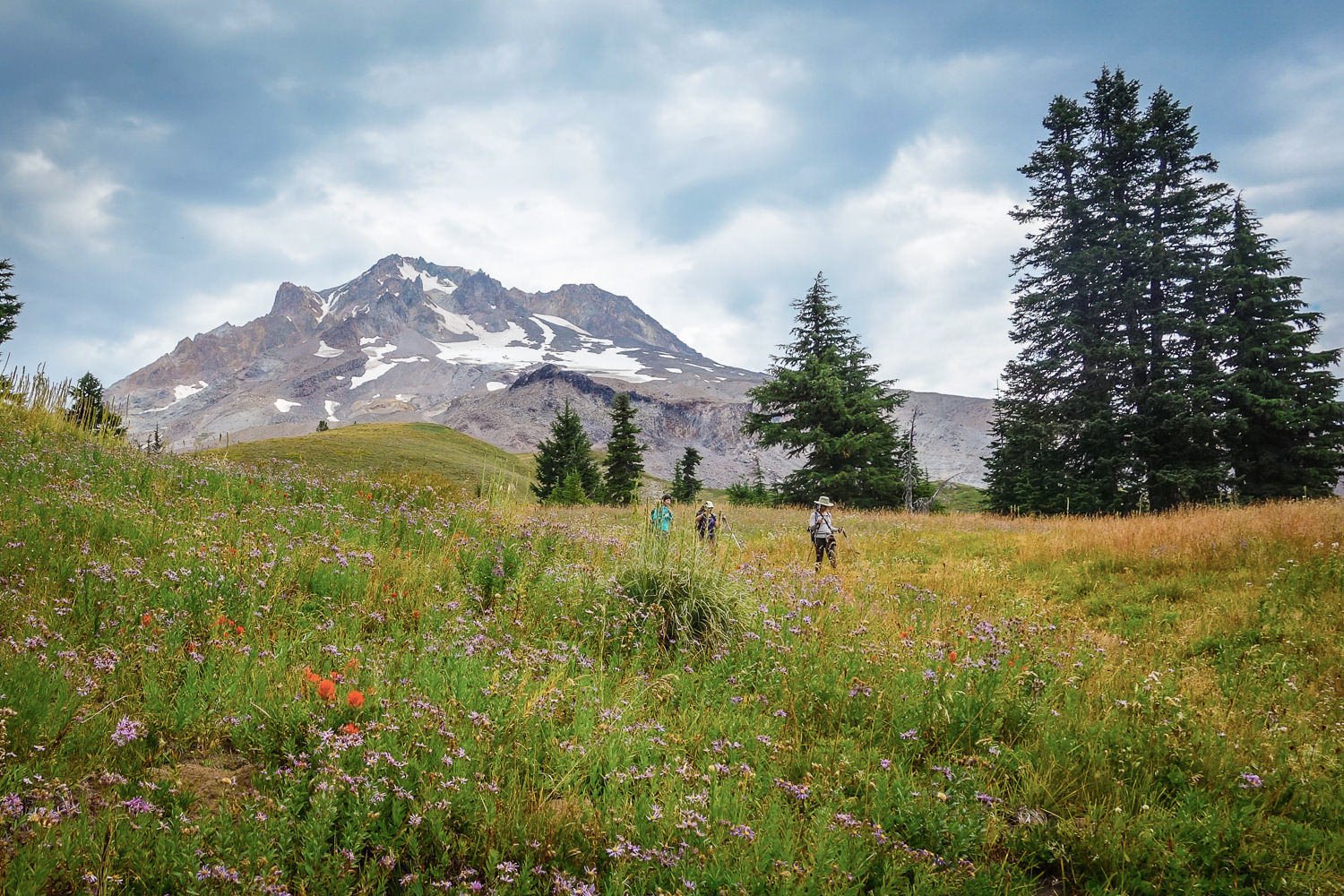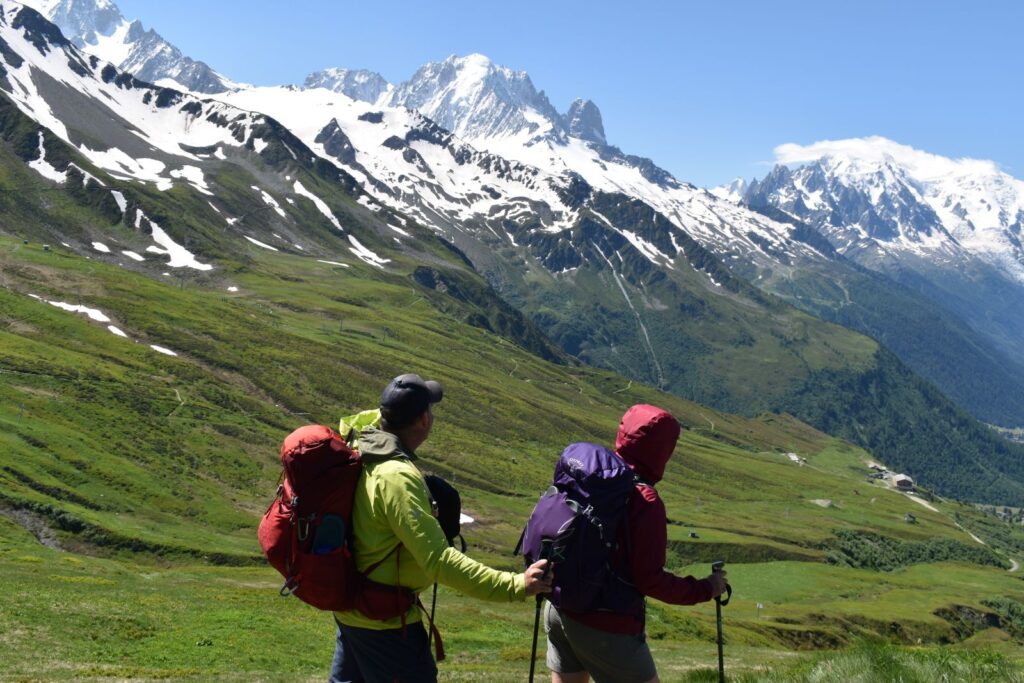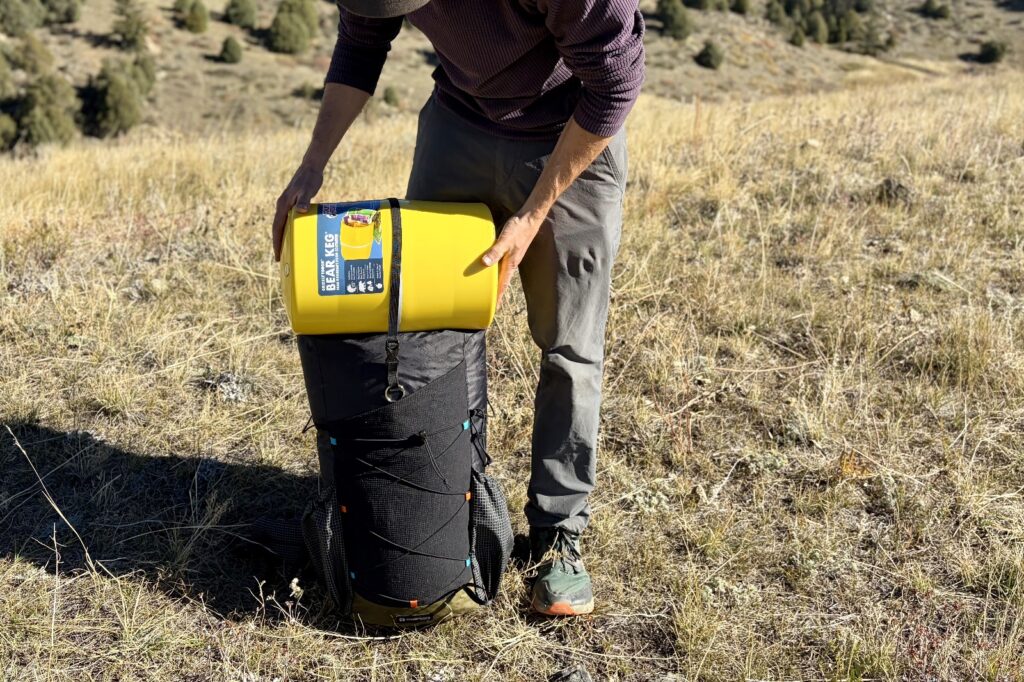
The Timberline Trail around Mt. Hood is one of Oregon’s most iconic and scenic trails. This 40-mile backpacking loop is a fantastic way to experience the immense size and beauty of Mt. Hood. On the Timberline, you’ll encounter lush old-growth forests, pristine alpine waterfalls, wildflower-filled meadows, towering craggy glaciers, rough volcanic landscapes, and some of the finest cascade views around. The hike certainly won’t be easy, with plenty of ups and downs along the way. But in the end, the reward for your effort will be well worth it. So if you haven’t backpacked the Timberline Trail yet, we highly recommend putting it on your list.

Quick Facts
- Distance: 38.3-mile loop
- Time Needed: 3-4 days
- Highest Elevation: 7,350 ft. Timberline High Point
- Lowest Elevation: 3,300 ft. Near Ramona Falls
- Elevation Gain (approx.): 9,000 ft.
- Best Time to Hike: July-September
- Permits: Yes (May 15th to October 15th)
- Difficulty: Challenging

Highlights
- Majestic Mt. Hood Views
- Cascade Range Vistas
- Massive Waterfalls
- Wildflower Meadows
- Immense Glaciers
- Easily Accessible
- Mostly Well Marked & Maintained
Lowlights
- Little Solitude
- Steep Climbs & Descents
- Seasonal Bugs & Snow
- River Fording

Permits
Permits are required for overnight trips on the Timberline Trail from May 15th to October 15th, but they are free and can be found at trailheads around Mt. Hood. Simply fill one out before you hit the trail. Some trailheads do require a Northwest Forest Pass for parking.

Regulations
Below is our summary of some key Mt. Hood Wilderness backpacking regulations. This is not an official or complete list, so please visit the Forest Service Wilderness Regulations page and the Mt. Hood Special Regulations page for the official rules.
- Leave no trace – If you pack it in, pack it out
- No motorized equipment
- No bicycles
- No groups larger than 12
- No shortcutting trails or switchbacks
- No damaging live vegetation
- No campfires within 100 ft. of lakes, streams, ponds, springs, or trails
- No entering restoration areas
- No camping within 100 ft. of any lake or the Pacific Crest Trail #2000
- No camping on any meadow, Elk Cove and Elk Meadows (in the tree islands), within 500 ft. of Ramona Falls.
- No campfire areas in any meadow, Ramona Falls and McNeil Point Shelter (within 500 ft.), Elk Cove and Elk Meadow (in the tree islands), Burnt Lake (at or within 1/2 mile), and 2 Areas around Paradise Park

Maps & Guidebooks
- Mt Hood Trail Map – This is a fantastic map for backpacking the Timberline Trail. We highly recommend picking it up. On our most recent Timberline trip, we met two different groups of hikers trying to complete this loop without maps. They were very confused/frustrated and asked to take pictures of our map to use as a reference while they hiked. For this reason, bring a detailed map whenever you backpack.
- Backpacking Oregon – This book is an excellent resource for the Timberline Trail and many other backpacking trips around Oregon. We highly recommend picking this book up as well. It’s got great play-by-play descriptions of the hike that are useful when planning out camping locations and side trips.

Best Time to Travel
In general, July-September is the best time to travel to this area.
Snowpack is a key factor in trip planning around Mt. Hood. Some years, a heavy winter snowpack and early-season storms will keep trails covered into July. In warmer years with lighter snowpacks, June backcountry trips are possible. The same is true for autumn hiking. Some years, early snowstorms make this area inaccessible, and in other years, it’s stable into October.
July and August are usually great for wildflowers. However, it is also when mosquitoes will be the worst. Use a combination of Permethrin on your clothing and a small amount of Picaridin on exposed skin for full protection. Mid-August through September can also be a good time to visit this area because crowds and bugs will be minimal.
There is a year-round possibility of snow, rain, and stormy weather around Mt. Hood. So pay close attention to the weather forecast before your trip and be prepared for changing conditions.

Difficulty
- Total Distance: About 40 Miles
- Total Elevation Gain: About 9,000 ft.
- Average Trip Duration: 4 Days
- Trail Conditions: Well-maintained with sections of loose/sandy trail
- River Crossings: Some river fording required (more info below)
Difficulty depends on your experience, physical fitness, pack weight, & weather conditions. This is not a technically demanding hike, but there are a few big climbs and descents along the way. There are also some sections of loose sandy trail, which can be tiring. Lastly, there are several rivers to ford along this hike (more info on that in a section below).
We would categorize this loop as a difficult hike. It’s not a great fit for beginners or families, but it’s an excellent hike for intermediate to experienced backpackers.
As always, the heavier your backpack, the harder your hike will be. So do yourself a favor and pack light. For lightweight hiking tips and gear recommendations, check out our tutorials page and gear guides.

ELEVATION
When people hear that the Timberline Trail goes around Mt. Hood, they assume that it’s mostly flat. After all, you’re going around the mountain, not up it, right? Well, not quite. Deep valleys and high ridges surround Mt. Hood on all sides, making this hike a series of climbs and descents. In all, you will gain and lose +-9000 ft. on this loop.

SOLITUDE
Mt. Hood is a very popular hiking destination, and the Timberline Trail is probably the most popular trail on Hood. So, you shouldn’t expect to be alone on this hike. That said, we’ve hiked this trail many times and rarely felt overwhelmed by other travelers.
To avoid the crowds, try to hike this trail mid-week and outside the summer rush from mid-July to mid-August.

WATER
Water is plentiful along this trail and is easily accessible from lakes and streams. However, some large glacial drainage water sources will be too silty to filter, so plan accordingly. The Oregon Hikers Timberline page has a good hike description that talks about some of the silty water sources. Carry plenty of water to get from one source to the next and a lightweight water purifier. Our current favorite is the Sawyer Squeeze, which we highly recommend grabbing for your trip.

RIVER FORDING
Any time you’re walking around a mountain, there are bound to be big rivers to cross. Some of the river crossings on this trail have bridges; some are small and will be easy to rock-hop across, and others may require a more challenging ford.
We made a tutorial video about fording rivers. We recommend it if you’re interested in learning the basics of river fording safety.
The difficulty of river crossings will greatly depend on the weather and the season. Also, glacier runoff rivers tend to flow weaker in the mornings because lower nighttime temperatures slow melting. Sometimes, the river crossings on the Timberline are very tame, and other times, they’re dangerously challenging. So take your time, plan a safe crossing route, and use your noggin.
When we most recently hiked this route in late August, we could cross most of the large rivers listed below without getting our feet wet. Even the most challenging crossings were never deeper than mid-calf height. However, that’s not always the case, and spring river crossings will often be much more challenging. It depends on the season, the snowpack, and water volume.
The following rivers generally require a ford. The rivers listed in bold are usually more challenging. Rivers are listed in clockwise order, starting from the Timberline Lodge.
- Zigzag River
- Sandy River
- Muddy Fork
- Coe Creek
- Eliot Creek
- Newton Creek
- Clark Creek
- White River

NAVIGATION
The Timberline trail is well-marked and maintained. However, trail closures from substantial blow-downs or wash-outs occur yearly around parts of this rugged volcano. You will likely use a bypass trail at some point on this loop. It is best practice to hike this trail with a topographical map and a GPS app downloaded on your phone (like Topo Maps+ or Gaia GPS). Even if the trail is 100% clear, it is very important to have a topo map for all the trail junctions you will intersect or if you happen to get lost.

Bears & Food Storage
Black bears do inhabit Mt. Hood National Forest, but sightings along this route are rare. However, even if you don’t encounter any bears, plenty of smaller animals will still be eager to access your food supply and may chew through your costly backpacking gear to reach it. That’s why proper food protection and storage are crucial in this area.
Nothing is worse than being exhausted and ready to go to bed and then realizing, you haven’t figured out how to hang your bear bag properly. Alternatively, you can carry a food storage container. Bear canisters and Ursacks are easy and effective ration containers. There are no food storage requirements for this area, but you should always store your food properly in the backcountry.

Planning your Itinerary
Most people start and end this loop at the Timberline Lodge. The most common hiking direction is clockwise from the lodge. That said, this is a true loop, so you can start and finish from any trailhead you like. It’s a good idea to visit Mt. Hood National Forest’s Timberline Trail page for current conditions. Checking in with the region’s ranger stations is also best practice when planning a backpack trip. Call or visit the Hood River Ranger District (541-352-6002) or the Zigzag Ranger District (503-622-3191). Trail closures from substantial blow-downs or wash-outs occur yearly around this rugged volcano. You will likely use a bypass trail at some point on this loop.
Some of the most common trailheads with easy access to the Timberline Trail are:
One nice benefit of starting at the Timberline Lodge is its incredible breakfast buffet. If you time it right, you can aim to finish your hike with an all-you-can-eat gourmet brunch feast, which is truly a treat.

Gear List
Make sure to check out our Ultimate Backpacking Checklist, so you don’t forget something important.
Below you’ll find our current favorite backpacking gear. If you want to see additional options, our curated gear guides are the result of many years of extensive research and hands-on testing by our team of outdoor experts.
BACKPACK
- Best Backpacking Pack Overall: Gregory Paragon 58 – Men’s / Gregory Maven 58 – Women’s
- Best Ultralight Backpacking Backpack: Hyperlite Mountain Gear Unbound 40
- More: Check out our best backpacking backpacks guide for ultralight and trekking options
TENT
- Best Backpacking Tent Overall: Big Agnes Copper Spur HV UL2
- Best Ultralight Tent: Zpacks Duplex
- Best Budget Tent: REI Half Dome 2
- Best Tent Stakes Overall: All One Tech Aluminum Stakes
- More: Check out our best backpacking tents guide for more options
SLEEPING BAG/QUILT
- Best Sleeping Bag Overall: Men’s Feathered Friends Swallow YF 20 / Women’s Feathered Friends Egret YF 20
- Best Quilt Overall: Enlightened Equipment Revelation 20
- More: Check out our best backpacking sleeping bags guide and best backpacking quilts guide for more options
SLEEPING PAD
- Best Sleeping Pad Overall: NEMO Tensor All-Season
- Best Foam Sleeping Pad: NEMO Switchback
- More: Check out our best backpacking sleeping pads guide for ultralight and trekking options
CAMP KITCHEN
- Best Backpacking Stove Overall: MSR PocketRocket 2
- Best Backpacking Cookware Overall: TOAKS Titanium 750ml
- Best Backpacking Coffee Overall: Starbucks VIA
- More: Check out our best backpacking stoves guide and best backpacking cookware guide for ultralight and large group options
WATER & FILTRATION
- Best Water Filter Overall: Sawyer Squeeze
- Best Hydration Bladder Overall: Gregory 3D Hydro
- Best Backpacking Water Bottles: Smartwater Bottles
- More: Check out our best backpacking water filters guide and best backpacking water bottles guide for ultralight and large group options
CLOTHING
- Best Hiking Pants Overall: Men’s Outdoor Research Ferrosi / Women’s The North Face Aphrodite 2.0
- Best Hiking Shorts Overall: Men’s Patagonia Quandary / Women’s Outdoor Research Ferrosi
- Best Women’s Hiking Leggings: Fjallraven Abisko Trekking Tights HD
- Best Rain Jacket Overall: Men’s Patagonia Torrentshell 3L / Women’s Patagonia Torrentshell 3L
- Best Rain Pants: Men’s Patagonia Torrentshell 3L / Women’s Patagonia Torrentshell 3L
- Best Down Jacket Overall: Men’s Patagonia Down Sweater Hoodie / Women’s Patagonia Down Sweater Hoodie
- Best Fleece Jacket Overall: Men’s Patagonia Better Sweater / Women’s Patagonia Better Sweater
- Best Sunshirt Overall: Men’s Outdoor Research Echo / Women’s Outdoor Research Echo
- Best Socks Overall: Men’s Darn Tough Light Hiker Micro Crew / Women’s Darn Tough Light Hiker Micro Crew
- Beste Ultralight Liner Glove: Patagonia Capilene Midweight Liner
- More: Check out our best backpacking apparel lists for more options
FOOTWEAR & TRACTION
- Best Hiking Shoes Overall: Men’s HOKA Speedgoat 6 / Women’s HOKA Speedgoat 6
- Best Hiking Boots Overall: Men’s Salomon X Ultra 5 GTX / Women’s Lowa Renegade Evo GTX
- Best Hiking Sandals Overall: Men’s Chaco Z/1 Classic / Women’s Chaco Z/1 Classic
- Best Camp Shoes Overall: Crocs Classic Clogs
- Best Traction Device for Hiking Overall: Kahtoola MICROspikes
- More: Check out our best backpacking footwear lists for more options
NAVIGATION
- Best GPS Watch Overall: Garmin Instinct 2 Solar
- Best Personal Locator Beacon (PLB): Garmin inReach Mini 2
- More: Check out our article How to Use Your Phone as a GPS Device for Backpacking & Hiking to learn more
FOOD
FIRST-AID & TOOLS
- Best First-Aid Kit Overall: Adventure Medical Kits Ultralight/Watertight .7
- Best Pocket Knife Overall: Kershaw Leek
- Best Multitool Overall: Leatherman Wave+
- Best Headlamp Overall: Black Diamond Spot 400-R
- Best Power Bank Overall: Nitecore NB 10000 Gen 3
- More: Check out our best first-aid kit guide, best pocket knife guide, best multitool guide, best backpacking headlamps guide, and best power banks guide for more options
MISCELLANEOUS
- Best Trekking Poles Overall: Black Diamond Pursuit
- Best Backpacking Chair Overall: REI Flexlite Air
- Best Backpacking Stuff Sack Overall: Hyperlite Mountain Gear Drawstring
- More: Check out our best trekking poles guide, best backpacking chairs guide, and best stuff sacks guide for more options

Support the Trail
We hope this guide helps you plan a trip along the Timberline Trail. If you do, you certainly won’t be disappointed. As always, please practice Leave No Trace principles when visiting the outdoors. Should you feel inspired to donate and volunteer to support the health of this wilderness and trail, visit Trailkeepers of Oregon to get plugged in. Finally, comment below if you have any recommendations, questions, or suggestions. Thanks!



